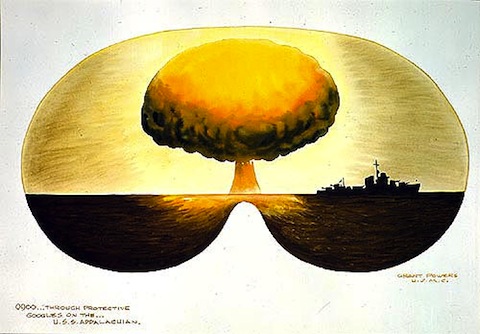
Followers of Microkhan’s microblog may have noted that I’ve developed a recent fascination with World War II-era combat art, which was created as part of an official War Department program to depict the conflict in oils, inks, and water colors. Once the the war was over, the painting continued as the U.S. speedily developed its nuclear weapons program, most notably by conducting atmospheric tests in the South Pacific. Three Naval artists were commissioned to record the destruction of Bikini Atoll in 1946; their work is now collected here.
The artists captured not only the ethereal beauty of the mushroom clouds, but also the damage wrought upon the ships that were placed in the explosions’ paths. Notably lacking from the collection? Any sense of the human toll caused by the evacuation of Bikini Atoll. We only get one glimpse of an abandoned village, where intact longhouses stand adjacent to a fluttering American flag. And then a painting of American military personnel at play. Yet there is a hint of malice to these paintings, a sense that the artists knew that they were bearing witness to events that would have unforeseen repercussions. There is no triumphalism in these artworks, only quiet awe.
More thoughts on the collection here, from a blogger with a keen interest in mushroom cloud kitsch.


scottstev // Jan 14, 2011 at 1:57 pm
I wonder how much controversy took place prior to and after the tests. Did the U.S. even give a second thought to relocating residents of a small island only to render it uninhabitable? Or did the combination of lingering colonial attitudes coupled with having to spend so blood capturing other small islands from the Japanese prevent any reflection?
Brendan I. Koerner // Jan 14, 2011 at 2:09 pm
@scottstev: Tough to understand the mindset of that era, but there seems to have been little consideration about the long-term consequences. The conventional wisdom was that American atomic testing was crucial to the world’s future, and so the welfare of 1,300 or so Bikinians paled in comparison. It’s also not clear to me whether the U.S. knew that the Atoll would be uninhabitable for generations–I think there was genuine surprise about the destruction involved, plus there was relatively little known about the long-term effects of radiation exposure.
Also, yeah, gotta keep in mind that this happened just a year after World War II ended. We were pretty used to running roughshod over Pacific islands at that point.
Tiara // Jun 14, 2014 at 8:47 am
Attractive component to content. I simply stumbled upon your site and in accession capital to claim that I acquire in fact loved account
your blog posts. Anyway I’ll be subscribing in your augment or even I achievement you access persistently fast.